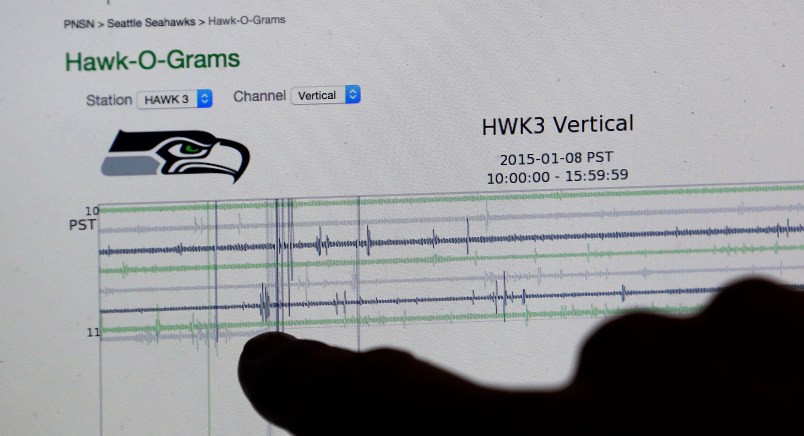SEATTLE (AP) — The jumps, stomps and roars of fans cheering on the Seattle Seahawks have been known to shake the ground around CenturyLink Field. Now scientists will use expected fan quakes during Saturday’s playoff game against the Carolina Panthers to experiment with an earthquake early warning system.
___
“BEAST QUAKE” INSPIRATION
Scientists first noticed the earth shaking around the Seahawks’ stadium during a 2011 playoff game when running back Marshawn Lynch broke eight tackles and ran 67 yards during a 13-second play against the New Orleans Saints. That run, considered one of the most impressive in NFL history, sparked a fan reaction big enough that it created a seismic tremor recorded by a monitoring station near the stadium. Fans jumped and stomped their way to a magnitude-1 or -2 earthquake.
It became known as the “Beast Quake” because of Lynch’s nickname.
“We became interested of what we could see if we put the instruments closer, right in the stadium with people in the stands,” said John Vidale of the Pacific Northwest Seismic Network.
___
PLAYOFF EXPERIMENT
University of Washington scientists with the Pacific Northwest Seismic Network installed three instruments in the stadium Thursday — two up in the stands and one by the playing field. Seismologists have used such instruments at the stadium in the past, but this year’s experiment features faster connectivity and readings.
A new tool called “QuickShake” is expected to display vibrations within three seconds, which is five to 10 times faster than the tool used with the sensors last year, the scientists said.
If a big plays prompts a fan quake, viewers monitoring the Pacific Northwest Seismic Network’s webpage will see the activity before they see it on television, which has about a 10-second delay during broadcast.
“The Seahawks experiment should provide us and the Internet-connected public with a feel for the minimum time early warning might provide,” said Steve Malone, a UW professor emeritus of Earth and space sciences.
___
EARTHQUAKE DRILL
Besides giving fans the option of monitoring the earth movement around the stadium, the seismologist are hoping to test their website’s traffic endurance and social media presence in an effort to go through the information dissemination procedures they would use during a real earthquake.
“It’s hard to simulate thousands of people using this tool all at once. When we can get a lot of people looking, we can see problems that we’d encounter during an actual earthquake,” Vidale said.
___
WHAT CAUSES THE SHAKING
The collective energy created by tens of thousands of fans jumping, clapping, stomping and swaying travels throughout the stadium, shaking the ground underneath, scientists said.
___
Online:
The Pacific Northwest Seismic Network’s Seahawks page: http://pnsn.org/seahawks
Copyright 2015 The Associated Press. All rights reserved. This material may not be published, broadcast, rewritten or redistributed.



